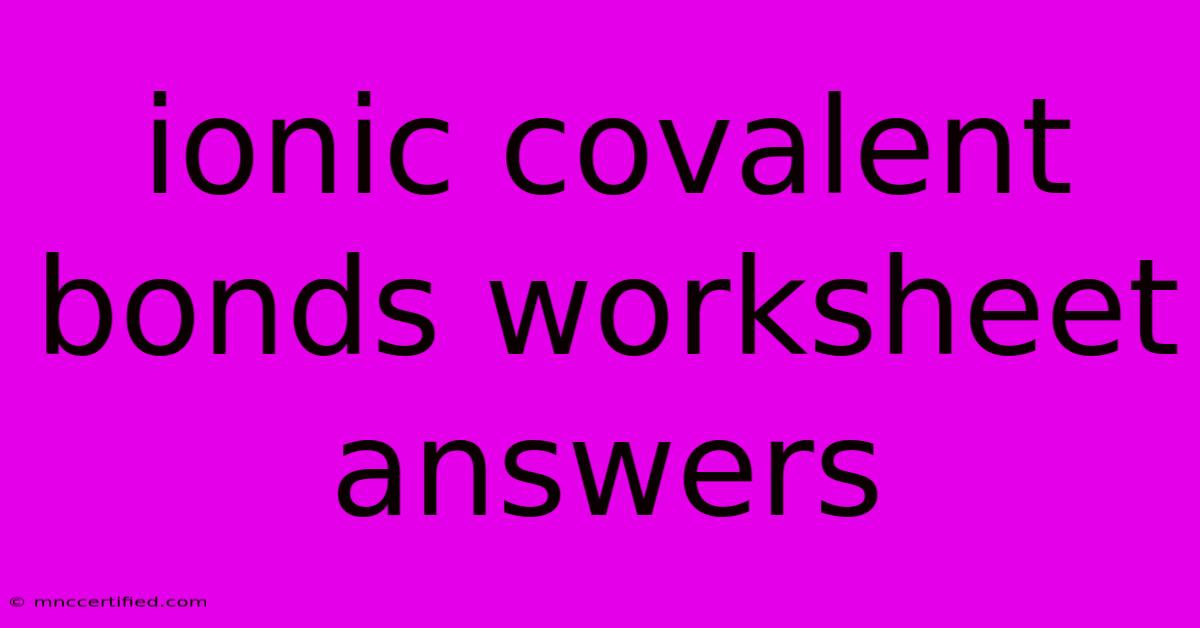Ionic Covalent Bonds Worksheet Answers

Table of Contents
Mastering Chemical Bonds: Ionic and Covalent Bonds Worksheet Answers
Understanding the fundamental concepts of chemical bonding is crucial for a solid foundation in chemistry. Ionic and covalent bonds are two of the most common types, and they play a key role in the formation of molecules and compounds. To solidify your knowledge, let's dive into the answers to a typical Ionic and Covalent Bonds Worksheet, focusing on key concepts and examples.
Ionic Bonds: The Attraction of Opposites
Ionic bonds arise from the electrostatic attraction between oppositely charged ions. This occurs when one atom donates an electron (forming a positively charged ion - cation) and another atom accepts that electron (forming a negatively charged ion - anion).
Key Characteristics of Ionic Bonds:
- High melting and boiling points: Strong electrostatic forces require significant energy to overcome.
- Good conductors of electricity in the molten state or when dissolved in water: Free ions are able to carry an electrical current.
- Hard and brittle: The rigid structure formed by the ionic lattice makes them strong, but also prone to shattering.
Worksheet Examples:
-
Identify the ionic compound formed between sodium (Na) and chlorine (Cl):
Sodium (Na) loses one electron to become a +1 cation (Na+), while chlorine (Cl) gains one electron to become a -1 anion (Cl-). The resulting compound is sodium chloride (NaCl).
-
Write the chemical formula for the ionic compound formed between magnesium (Mg) and oxygen (O):
Magnesium (Mg) loses two electrons to become a +2 cation (Mg2+), and oxygen (O) gains two electrons to become a -2 anion (O2-). The balanced formula is MgO.
Covalent Bonds: Sharing is Caring
Covalent bonds occur when two atoms share electrons to achieve a stable electron configuration. This sharing creates a strong bond holding the atoms together.
Key Characteristics of Covalent Bonds:
- Lower melting and boiling points: Compared to ionic compounds, the forces between molecules are weaker.
- Generally poor conductors of electricity: The shared electrons are tightly bound and don't easily move.
- Can exist as gases, liquids, or solids: The strength of the bonds and the intermolecular forces influence their physical state.
Worksheet Examples:
-
Draw the Lewis structure for a water molecule (H2O):
Oxygen (O) has six valence electrons, while each hydrogen (H) has one. Oxygen shares its electrons with two hydrogen atoms, forming two covalent bonds. The Lewis structure will show the oxygen atom in the center with two hydrogen atoms bonded to it.
-
Identify the type of covalent bond (single, double, triple) present in the nitrogen molecule (N2):
Nitrogen (N) has five valence electrons. To achieve a stable octet, each nitrogen atom shares three electrons with the other, resulting in a triple covalent bond.
Mastering the Concepts: Tips for Success
- Understanding electron configuration: Familiarize yourself with the arrangement of electrons in different atoms.
- Practice drawing Lewis structures: This will help you visualize the sharing of electrons in covalent bonds.
- Identify the types of ions formed: Recognizing how atoms gain or lose electrons to achieve stability is crucial.
- Memorize common polyatomic ions: These will help you write formulas for ionic compounds.
By understanding these key concepts and practicing with worksheets, you can master the intricacies of ionic and covalent bonding, building a strong foundation for further exploration of chemistry.

Thank you for visiting our website wich cover about Ionic Covalent Bonds Worksheet Answers. We hope the information provided has been useful to you. Feel free to contact us if you have any questions or need further assistance. See you next time and dont miss to bookmark.
Featured Posts
-
Unladen Insurance For Rv Transport Cost
Nov 09, 2024
-
Lurie Poised To Win San Francisco Mayoral Race
Nov 09, 2024
-
Chloe East On The A24 Horror Heretic
Nov 09, 2024
-
Daniel Lurie Levi Strauss Heir Enters Politics
Nov 09, 2024
-
How To File A Claim With Gap Insurance
Nov 09, 2024